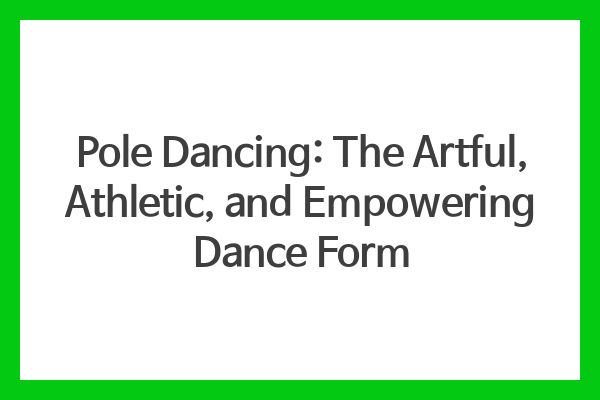Introduction
Pole dancing is not just a provocative dance form associated with strip clubs. It is a unique combination of artistry, athleticism, and empowerment. Over the years, pole dancing has gained recognition as a legitimate form of exercise and self-expression. In this blog post, we will explore the various aspects of pole dancing and its growing popularity.
The Mind-Body Connection
Pole dancing requires a strong mind-body connection. It is a physically demanding activity that requires strength, flexibility, and coordination. Practicing pole dancing provides a full-body workout, targeting muscles that are often neglected in traditional exercise routines. The dance form also promotes self-confidence and body positivity.
Related keywords: exercise, self-expression, strength, flexibility, coordination
Empowerment and Self-Expression
One of the most significant aspects of pole dancing is its ability to empower individuals. It allows dancers to express themselves physically and emotionally, breaking free from societal norms and expectations. Pole dancing enables people to embrace their bodies and celebrate their individuality. It fosters a sense of empowerment and liberation.
Related keywords: empowerment, self-expression, individuality, liberation
Community and Support
The pole dancing community is known for its inclusivity and support. It offers a safe space for individuals to explore their creativity and develop their skills. Pole dance studios often create a supportive environment where dancers can connect with like-minded people and build friendships. The community aspect of pole dancing plays a crucial role in empowering individuals to pursue their passion.
Related keywords: community, support, safe space, creativity, friendships
Breaking Stereotypes
Pole dancing has long been associated with negative stereotypes and misconceptions. However, it is essential to challenge these preconceived notions and view pole dancing for what it truly is: an art form. By shifting the focus from the sexual objectification of pole dancing to its artistic and athletic aspects, we can break down the societal barriers that limit its acceptance.
Related keywords: stereotypes, misconceptions, art form, athletic
Bridging the Gender Gap
Pole dancing has traditionally been viewed as a woman-centric dance form. Still, it is important to emphasize that anyone can participate and benefit from it. While pole dancing has predominantly female practitioners, there is an increasing number of men who are finding joy and fulfillment in this dance form. Breaking the gender norms associated with pole dancing promotes equality and inclusivity.
Related keywords: gender gap, inclusivity, equality, male dancers
Problem Statement
Despite its growing popularity and numerous benefits, pole dancing still faces challenges in gaining mainstream recognition. The negative stigma, stereotypes, and lack of understanding often hinder the acceptance of pole dancing as a legitimate art and sport. These barriers prevent more people from experiencing the physical and emotional benefits it offers.
Addressing the Challenges
To overcome the challenges faced by pole dancing, education and awareness are crucial. By promoting the artistic and athletic elements of pole dancing, we can shift the narrative and challenge societal misconceptions. Offering more beginner-friendly classes and workshops can also attract a wider audience and encourage more people to give pole dancing a try.
Additionally, collaborations between pole dance studios and other fitness disciplines can help bridge the gap between traditional exercise routines and pole dancing. By highlighting the physical benefits of pole dancing, such as increased strength, flexibility, and cardiovascular endurance, it can garner more acceptance and recognition within the fitness industry.
Advantages and Benefits
Pole dancing offers a myriad of advantages and benefits. It provides a unique and engaging form of exercise, promoting overall physical fitness and mental well-being. It challenges individuals to push their boundaries and build strength both physically and mentally. Pole dancing also cultivates self-expression, body positivity, and a sense of community, fostering personal growth and empowerment.
Conclusion
In conclusion, pole dancing is far more than just a provocative dance form. It is an artful display of athleticism and self-expression that empowers individuals to challenge societal norms and celebrate their bodies. By educating and promoting awareness, pole dancing can gain the recognition it deserves as a legitimate and empowering dance discipline. Let us embrace the strength, grace, and creativity that pole dancing brings into our lives and celebrate the diverse community it fosters.
